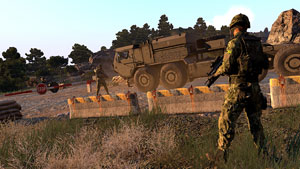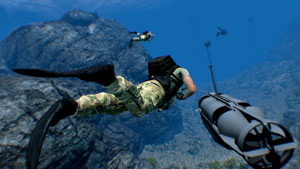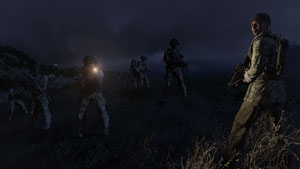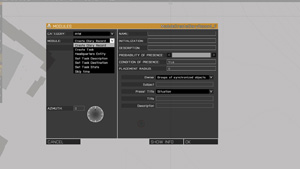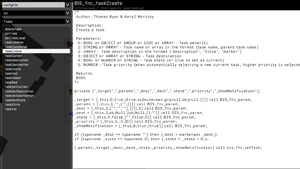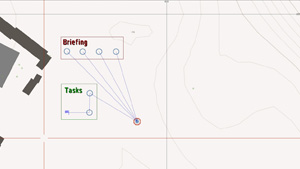Having survived the first campaign episode, and preparing to adapt for the next one, we asked one of the campaign creators, Designer Thomas Ryan, to Report In™!
We're often asked to let some of our people talk about what it's like to develop a game at BI. 'Report In!' gives you a more personal perspective on our team, a more detailed look at the way we go about our work, and fresh information about our ongoing projects.
As a Mission Designer, Thomas is heavily involved in the development of Arma 3’s official campaign. Using this to our advantage, we ask him all about the development process, the episodic release strategy, and the campaign additions for content creators. We also discuss his splendid background in the community, and what it’s like to be turning your hobby into a profession.
Introduction
Tell the people a little about yourself. What's your role? How long have you been with Bohemia Interactive? Which projects have you contributed to and what is your favorite BI game or mission?
[thumb class="pull-left" clear-xs]thomas_ryan.jpg[/thumb] I’ve been a Designer here at Bohemia Interactive for just over two and a half years now (man, time flies). Initially, I was brought onboard to work on Take On Helicopters, but I eventually progressed to Arma 3 along with the rest of the team.
Choosing a favorite mission is a tough one. I think I'll have to say Abandoned Armies by THobson, a true classic from the old days that showed me just what was possible back before I started taking mission design seriously. I don't think any mission I've played since has been able to capture the experience of playing Abandoned Armies for the first time, but there are many which have taken inspiration from it, including my own.
And can you give us a random fact about yourself?
Although I was born in Canada, I spent most of my life living in the Middle East. Unfortunately, I missed out on learning Arabic while I still had the chance.
Man on a Mission
What is your part in the creation of Arma 3’s campaign?
My primary directive, shall we say, is mission design; everything from prototyping, to writing, through to testing. I have, however, contributed to some of the system design for the campaign and other parts of the game as well. I created the menu scenes for Altis and Stratis, for example.
Which other people/departments are involved in the development of Arma 3’s campaign?
[thumb class="pull-left" clear-xs]report_in_ep_1_8.jpg[/thumb] It’s an effort that involves the whole team, really. Obviously, a lot of the responsibility rests on the shoulders of the core campaign team, but we could not accomplish our goals without each department pitching in. For example, we cooperate extensively with the Environment team. They’ll tell us about cool locations to show off (or ones we should leave to you to explore), and we’ll tell them what changes/additions/improvements we need in order to achieve our intended design. For example, we asked for particular attention to be paid to the opening underwater segment of Wet Work, and the results clearly show.
Jay Crowe (Creative Director on Arma 3) already explained some of the goals and ideas behind the Arma 3 campaign in his latest blog post. Can you briefly summarize what you are after with ‘The East Wind’ campaign?
I would say we tried to go back to our roots, to make the player feel a sense of insignificance again. Not in terms of their actions have no consequences. Rather, in that they are a small cog in the greater war machine. I believe this gives you a greater idea of the bigger picture, as you recognize you are not the one fighting on the ground, in the air and on the sea. Instead, you rely on your virtual comrades to aid you as you advance.
We also opted for a gameplay-driven development approach this time around. We build missions that we believe provide fun and engaging gameplay, and then we bend and manipulate the story to work around them where possible. In the past, there were many instances when we were somewhat hindered in what we could do by what had been set-in-stone by the narrative. We decided gameplay should have priority.
So then, more practically speaking, how does the development of a campaign start and progress?
[thumb class="pull-left" clear-xs]report_in_ep_1_2.jpg[/thumb] The development of campaigns starts with a question: what do we want to accomplish? From there, we proceed to: how? It involves a significant amount of trial, error, and iteration. Sometimes we’ve had to scrap entire missions and do them again because we just weren’t happy with where they were going. Once we have some prototypes in place, we begin testing, both for form and functionality, shall we say. We need to know if the missions work from both a technical and practical perspective. If the mission logic works flawlessly but the player doesn’t enjoy the mission, I would say that’s worse than the mission just not working at all.
What happens in the latest stages of the campaign’s development?
Testing really comes into full swing, of course, but now’s the time to add the layers of polish on top of what already exists. I, as the mission’s designer, have been able to visualize and imagine how I want certain things to look and behave come the final release, but adding a lot of this just isn’t practical or possible until the later stages. It is now that our vision for the campaign becomes clearer to those outside of the core team. One of the biggest aspects of this is the addition of voice acting; the difference in feeling between a silent mission with subtitles, and a fully voice-acted one, is night and day.
What are the most significant challenges (in general, but also specific to Arma 3) when developing an Arma campaign? Did the Alpha and Beta have any influence?
POSSIBLE SPOILERS:
[thumb class="pull-left" clear-xs]report_in_ep_1_5.jpg[/thumb] The aforementioned trial, error, and iteration would have to take the cake. You would probably be surprised at how many times we revisited the opening mission of Survive until we were happy with it. A little bit of trivia: we released a Stratis teaser trailer just over a year and a half ago. The focus for most of it is on the player and his team walking up a dirt road on Stratis, with Air Station Mike-26 looming in the background. This was lifted directly from one of the earliest concepts of the opening mission; the music, ambient radio chatter, composition, all of it. Stratis was a new island at the time, even for us, and we felt this showed it off perfectly for the purposes of this short teaser. You can see just how much things can change (almost everything…) and how much they stay the same (… except for the walking). Eagle-eyed viewers may note that even Kerry’s helmet changed.
As to whether the Alpha and Beta had influence; we learned a lot about what people enjoyed and what they didn’t. Some players have noticed that Death Valley in Survive is almost identical to the Infantry Showcase that came with the Alpha, with a few notable exceptions. Going back to what I said about our gameplay-driven approach to development; we had a lot of working mission concepts early on. This mission was one of them. We liked its gameplay so much that we decided to strip it of its story elements and add it to the Alpha, swapping the AAF for CSAT in the process (or “OPFOR,” as they were called in the Alpha and Beta).
It wasn’t perfect, and we took a lot of the feedback to heart; the team in the town was made to fire on the enemy around them, we redesigned the mechanics of the entire spotters segment and, of course, we made a fairly significant change to the finale. We also tried to better explain how the player and his team got into such a messy situation in the first place. However, we were set on keeping it as tough as ever. It’s funny to see that some regard this as their most favorite mission in Survive, while others think it’s the worst. Mission accomplished! I’ve already seen talk of others wanting to apply their own spin on the mission, and I look forward to seeing what they do with it.
Rule of Three
The campaign is being released across 3 episodes. What did or does this mean for your work; did anything change in terms of story or missions?
POSSIBLE SPOILERS:
I believe the episodic approach is allowing us to provide a much more polished experience on launch than we have in the past, as I believe the reception to Survive has proven. That’s not to say it’s been perfect, of course; work is still on-going to improve certain aspects of the individual missions, and fix issues that players have run into. We’ve learned a lot from the release of just Survive alone, the results of which I hope you’ll see in the coming episodes.
[thumb class="pull-left" clear-xs]report_in_ep_1_5.jpg[/thumb]In terms of a direct impact on the story or missions, here’s another piece of trivia: the ending sequence to Survive was actually originally the opening to Adapt, with Survive ending as the survivors sailed away from the shores of Stratis. However, when we decided to go with the episodic approach, we believed this scene was better suited to end Survive and leave the players wanting more, thus we made it so. Throughout Survive, though, we made careful considerations as to what we wanted to reveal, or keep secret until the following episodes. We’re only at the beginning, after all.
The episodes are called Survive, Adapt, and Win. The first episode ‘Survive’ has just been released. Can you tell us how the theme of ‘surviving’ is incorporated?
POSSIBLE SPOILERS:
[thumb class="pull-left" clear-xs]report_in_ep_1_6.jpg[/thumb] The global situation in Arma 3 pits NATO pretty much on the losing end, with an ever-growing competitor looming in the east; the Canton Protocol Strategic Alliance Treaty, or CSAT for short. We wanted things to go badly for Kerry and, by extension, the player. We wanted to test how they would react when faced with such situations. The AAF, whom NATO considered a (reluctant) ally, turns on them as they are pulling out, motives uncertain (for now), and decimates the majority of NATO forces left behind, leaving only the player and a few survivors to, well, survive. Stratis is a small place, and the survivors have very little time to put together a plan of action. Needless to say, not everything goes according to plan.
When thinking about what gameplay we wanted, we wanted the player to be on the receiving end of hell on a lot of occasions. We wanted him under-equipped and outnumbered though, sometimes, pulling through. However, most of their victories end up being partial. But Kerry, and the player, has to put a lot of faith in his superiors, and he only recognizes a few of them, if he knows them at all. Not, perhaps, the situation most soldiers want to find themselves in when faced with such odds.
Stories typically contain an introduction, body, and conclusion. Should we consider Survive as the introduction? How do you introduce a setting, story, and characters?
Survive is definitely the introduction. Adapt and Win will take what you learn here and push you harder, giving you more freedom and autonomy as you progress, as well as introducing you to the more complex aspects of Arma 3. Here, we wanted to teach you the basics; essentially, how to survive.
[thumb class="pull-left" clear-xs]arma3_survive_screenshot_06.jpg[/thumb] Apart from its technical purpose, its narrative purpose is to set the scene. We wanted to introduce the player to our world, to the characters he’ll see throughout the remaining episodes, and to start him off on the story we want to tell. We give the player a brief lesson on the global situation at the time. We then introduce him to certain characters and their motivations, though a lot is deliberately left unclear. Finally, we knew that the survivors had to get off Stratis by the end of Survive, and we set the wheels in motion, with all roads eventually leading the player to Altis.
The first campaign episode also seems a good place to start for newcomers. However, it’s not really like there are specific tutorials. What are you doing to ease these players into Arma 3?
Survive is definitely the starting point, intending to teach newcomers the fundamentals. Moving up through the tiers as the episode progresses, you start off with basic combat, before moving on to basic squad combat, and then some wildcards get thrown into the mix, such as mortars, underwater, and night-time operations. These really are the basic of basics in Arma 3, and you will need to be familiar with them to progress in the coming episodes.
Outside of our "learning through play" approach, we have also introduced a new, key mechanic in Survive: the Instructor Figure. An optional game setting, which you can easily opt-out of, the Instructor Figure is a system that gives the player context-appropriate assistance in missions where we deemed it necessary, presented in the form of in-universe conversations involving campaign characters. The idea was to provide tips that could help the player in some of the more complex situations, many of which we determined during our phases of focus testing. The idea was not to draw the player out of the experience by throwing him into some cutscene or presenting him with a book to read. Rather, we treat it as if it's almost a story event, which helps to keep the player immersed while also pointing them in the right direction.
By now most of us are familiar with the principles of Arma 3: authenticity, diversity and opportunity. How do these fit in with the campaign? Where do you get your inspiration and reference materials from?
The first episode has to be rather diverse by its very nature. We have to introduce a lot of new concepts to the player and make sure he’s familiar with them. We also try to show off Stratis, using different locations and setups as much as possible for each mission (though, sometimes it’s not possible due to narrative or map size constraints, but we try to avoid this). Authenticity, on the other hand, takes on various different forms in Survive. A big one is that we try to keep the voice acting authentic to the situation, for example, but, on the other hand, we achieve authenticity in other areas, such as the feeling of disorganization and survival that is present throughout.
[thumb class="pull-left" clear-xs]report_in_ep_1_4.jpg[/thumb] In terms of inspiration, I would have to admit that a lot of it came from analyzing our previous campaigns, with special attention paid to the campaigns of Operation Flashpoint (Arma: Cold War Assault). These were arguably the most positively-received campaigns in the series’ history. On a personal level, OFP was what got me hooked. I would hedge my bets that it got a lot of our fanbase hooked, too. I tried to examine why. To give an example of what I learned: you can have prolonged periods of the player moving slowly through the terrain, so long as something is happening. There were many prolonged travel sections throughout OFP’s campaigns, but something was almost always happening to keep you engaged. That “something,” could be as simple as a conversation between your squad mates, environmental sound effects or, going even simpler, short musical queues. This became important, as our terrains are getting larger and larger, and it was critical to creating the opening moments of Survive.
Can you already give us a few hints on what to expect in the next episode(s)?
POSSIBLE SPOILERS:
Well, without giving too much away, I will say that all is not as it seems. A lot of the questions you have been asking after playing Survive are there for a reason, and many will be answered as early as Adapt. As I said before, we are only at the beginning.
Besides the new playable content, the first campaign episode also delivers a lot of extra modules and content for the content creators in the Arma 3 community. How relevant is this, and what can people use it for?
[thumb class="pull-left" clear-xs]report_in_ep_1_1.jpg[/thumb] One of the most noticeable new additions is the vast library of new animations we’ve added. I know from my own past experience that, although a lot of these have been purpose-fitted for use in Survive, content creators will find ways to use them in ways that are likely to surprise us. Aside from this, there are the new music tracks that are, arguably, some of my favorite in the game, and, of course, the various new weapons. I hope each will serve to spice up future unofficial content!
Coming to Bohemia
You’ve joined Bohemia Interactive after serving in the Arma community for many years. How was this transition?
What a lot of people don’t realize is that a large part of our team consists of former community members, and active community members are involved in the development process more than you may think. As such, I had a bunch of people around me who had gone through the same process before and could help with the transition. I’ve done a lot of traveling in my life, so the actual physical transition of moving to a new country was relatively simple, but definitely no less nerve-racking!
What are the differences between working at Bohemia Interactive, and developing user-content as a hobby?
The major difference is definitely that it’s now your job. As the developer, you’re expected to set the example for others to learn from, and improve on. This comes with a whole added layer of pressure, though I believe this only motivates you to do better than you did before, and learn from your mistakes.
And what are the similarities?
Your goals don’t really change; you still do what you do to experiment and learn, and, hopefully, you have the added bonus of your fanbase appreciating and enjoying the fruits of your labor. In a more to-the-point sense, most of the tools available to our playerbase are the same ones used by us. For example, I made all of my missions in Survive using the same Editor available to you in the main game, along with the same tools available to you in our Editing Tools suite.
Which things you made before joining Bohemia Interactive are you the most proud of? And what is perhaps the most ridiculous/fun/outrageous thing you made?
Without a doubt, I am most proud of my two unofficial campaigns for Arma 2; Operation Cobalt and Blood On The Sand. These were huge learning experiences for me (I had set the goal for myself with Operation Cobalt to make it entirely in SQF, which forced me to learn it and stop using SQS) and, as it turns out, they were rather life-changing. However, looking back at both, I may have to say they are arguably the most terrible things I made. I took a nostalgia-trip into their code recently and, I’ll admit, I was disgusted by the standard of my code and the methods I employed to achieve certain effects. Luckily, the player doesn’t see this; he only sees what he plays. I’m also pretty hard on myself.
The most ridiculous/fun/outrageous thing I made? Well, I think I’m going to have to say the “teaser” trailer I made for Blood On The Sand. I think those who’ve seen it will agree. At the time, I believed I had achieved the perfect marriage between Coldplay and Arma… I really didn’t. This is all disregarding the fact that it’s a 2-minute-long “teaser.” Though, I will say; I still like the titles I used in it!
Do you still make (unofficial) stuff in your free time?
Definitely. It’s been quite some time since I’ve released anything, as my current responsibilities require my full dedication. I do regularly experiment in my free time. It’s my hobby, one of my favorite things to do. Will I release any unofficial stuff in the future? Well, never say never, I suppose.
Last but not least, you’ve hosted a couple of official Arma 3 livestreams in the recent past. Will there be more? Say YES!
Yes. Is that all you wanted? No? Well, I think the ones we’ve hosted so far have been quite successful, bar a few technical issues. The main thing preventing us from hosting more currently is probably time, but, without revealing too much, we’re currently working on something which I believe is perfectly suited for livestreaming.
General questions
And after a long day of making games, what do you like to do to relax and unwind?
To be honest, I’m perfectly content with coming home and playing them instead! Other than that, going to dinner with friends, often accompanied by a movie, is fantastic.
What tip(s) would you give to the Arma 3 content creators out there?
[thumb class="pull-left" clear-xs]arma3_survive_screenshot_08.jpg[/thumb] If you’re serious about it, I’d recommend making it about learning and improvement. I see a lot of code in unofficial content that has been copied from a single source, for example. That’s fine. It’s how, I think, all of us started the learning process. However, try to examine this code you’re using; look at what exactly it’s doing. If something doesn’t work, try to figure out why on your own, before involving others. Big tip: add -showScriptErrors to your shortcut’s target line. This will help you a lot with debugging your code.
Concentrating specifically on budding mission designers, I also see a lot of code that is a 1:1 direct copy of how things were done in Arma 2. A common example of this is mission briefings. Remember that Arma 2 and Arma 3 are not the same game; a lot of the functionality you’re looking for may now exist in official capacity. Some of you may feel uncomfortable changing your perhaps “tried and true formula,” from Arma 2, which is understandable. But, if we’re still being serious about it, don’t get complacent. Check out the Intel category under Modules in the Editor, and have a look at the Tasks category within the Functions Viewer, also accessible through the Editor. You’ll find a lot of the briefing technology is now officially supported by us, and you may actually find it easier to use. You don’t know until you try.
A new super villain, The Crash, causes global mayhem by destroying video games from all over the world. Fortunately, after being bitten by a modified game bug, you are blessed with special powers. Using your code-slinging abilities, which game would you set out to protect?
I’m understandably tempted to say OFP, since it’s the one game I’ve always had on my PC since it came out. However, if I were to disqualify it, then I would have to say The Elder Scrolls V: Skyrim, preferably with a whole plethora of mods installed. I’m sensing a common theme here, what with all the open-world sandbox games, with added moddability…
